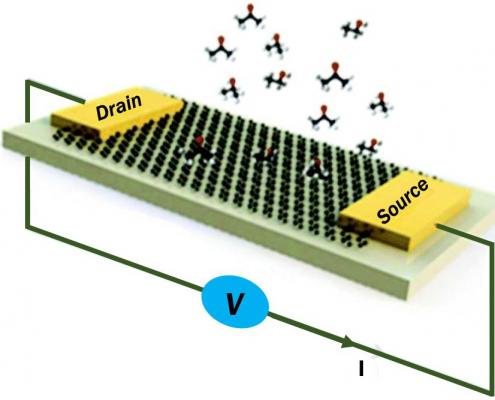
Scientists have created a new technique that could create an extremely sensitive graphene biosensor. The biosensor would be able to detect molecules of the most common lung cancer biomarkers. In other words, it could diagnose lung cancer earlier than current systems.
The researchers, from the University of Exeter and the École Nationale Supérieure de Mécanique et des Microtechniques, have written about their work in the journal Nanoscale (citation below). The authors were E. Kovalska, P. Lesongeur, B. T. Hogan, and A. Baldycheva.
The authors believe that their new graphene biosensor could revolutionize e-nose (electronic nose) devices. Specifically, devices that identify certain components of a specific vapor mixture such as a person’s breath.
Graphene biosensor – a cheap and accurate breath test
Co-authors, Ben Hogan, a Postgraduate Researcher at Exeter, said:
“The new biosensors which we have developed show that graphene has significant potential for use as an electrode in e-nose devices. For the first time, we have shown that with suitable patterning graphene can be used as a specific, selective and sensitive detector for biomarkers.”
“We believe that with further development of our devices, a cheap, reusable and accurate breath test for early-stage detection of lung cancer can become a reality.”
Scientists worldwide have long been trying to find a new and effective technique to detect early-stage lung cancer.
Lung cancer kills approximately 1.4 million people globally each year. It is a difficult illness to treat because diagnosis only occurs at the later stages. By that time, the chances of an effective treatment are minimal.
In other words, when most lung cancer patients are diagnosed it is too late.
Their unrestrainable nature means that abnormal lung cancer cells spread from the lungs to other parts of the body quickly.
Using graphene to make an enhanced biosensor
Today, there is no simple, cheap, or widely available screening method for diagnosing lung cancer early. In this latest study, researchers tried to determine whether graphene might be the solution.
In other words, they tried to find out whether graphene could form the basis for an enhanced biosensor.
Regarding e-nose devices, the team believes that we could revolutionize breath diagnostic techniques using multi-layered graphene. E-nose devices combine electronic sensors with pattern recognition mechanisms.
Graphene biosensor was extremely sensitive
With patterned multi-layered graphene electrodes, the researchers demonstrated greater sensing capabilities for ethanol, acetone, and isopropanol across a wide range of different concentrations. Acetone, ethanol, and isopropanol are among the most common lung cancer biomarkers.
Their findings could be the first step towards developing new, cheaper, and improved e-nose devices, the authors wrote. These new devices would be able to diagnose lung cancer much earlier.
Graphene
Graphene is the strongest and thinnest material in the world. It is over 200 times stronger than our strongest steel. It is also the world’s lightest material.
Graphene is a single layer of pure carbons arranged in a hexagonal lattice pattern. Scientists say that it is so thin that they consider it as a two-dimensional object.
Graphene is also the world’s best conductor of heat and electricity.
Citation
“Multi-layer graphene as a selective detector for future lung cancer biosensing platforms,” E. Kovalska, P. Lesongeur, B. T. Hogan, and A. Baldycheva. Nanoscale, 2019, 11, 2476-2483. DOI: 10.1039/C8NR08405J.

